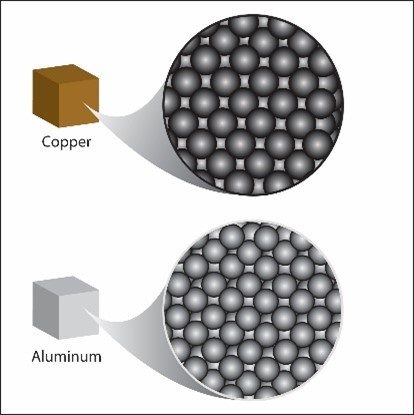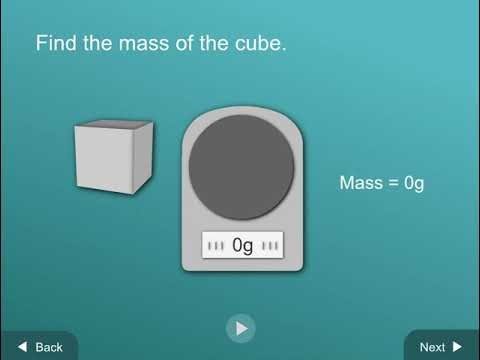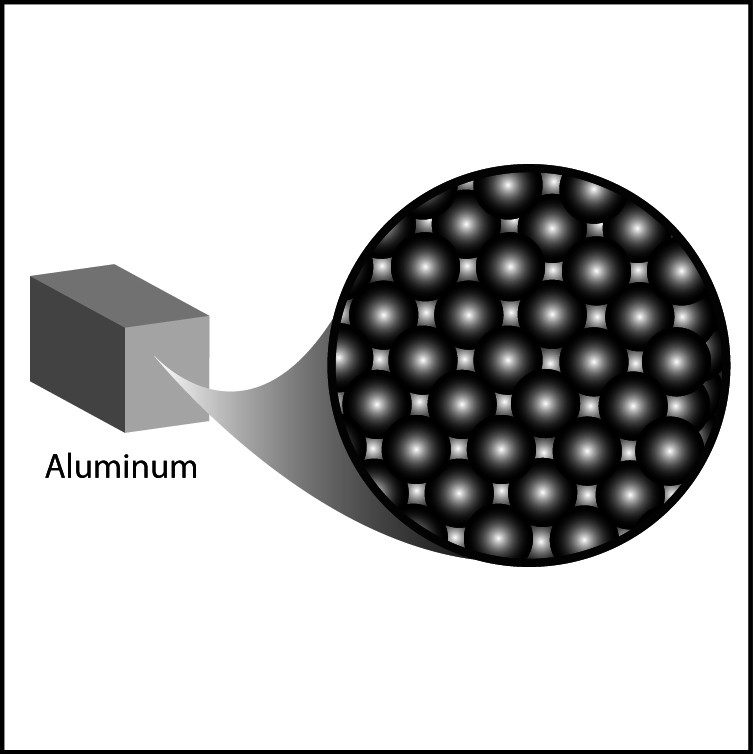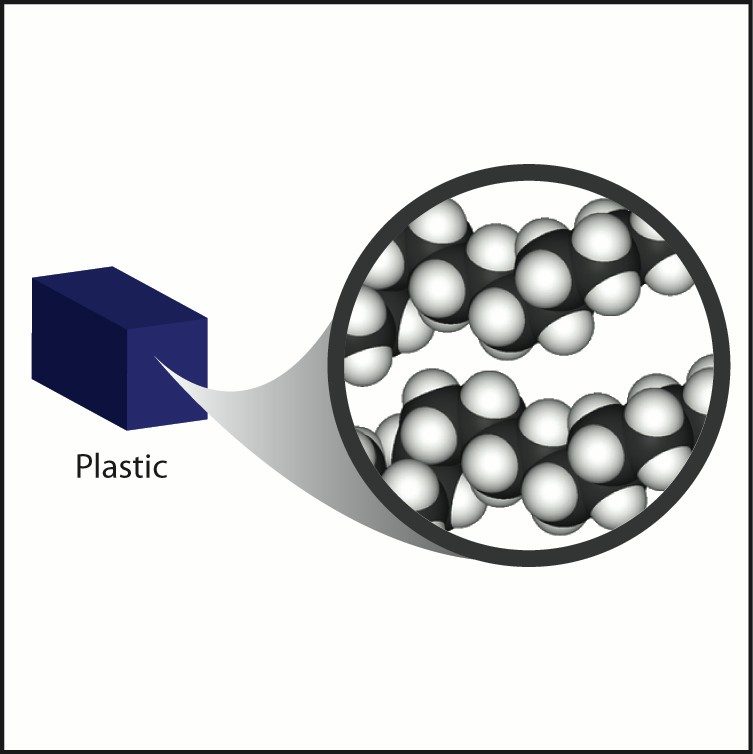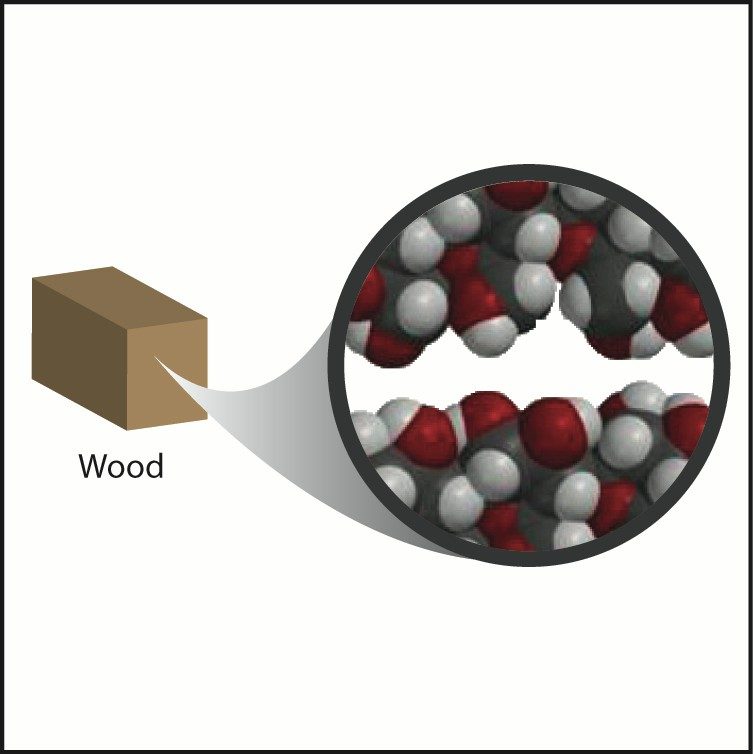What is Density?
Lesson Summary Video for teachers
Note: This video is designed to help the teacher better understand the lesson and is NOT intended to be shown to students. It includes observations and conclusions that students are meant to make on their own.
Key Concepts
- Density is a characteristic property of a substance.
- The density of a substance is the relationship between the mass of the substance and how much space it takes up (volume).
- The mass of atoms, their size, and how they are arranged determine the density of a substance.
- Density equals the mass of the substance divided by its volume; D = m/v.
- Objects with the same volume but different mass have different densities.
Summary
Students will observe a copper and an aluminum cube of the same volume placed on a balance. They will see that the copper has a greater mass. Students will try to develop an explanation, on the molecular level, for how this can be. Students are then given cubes of different materials that all have the same volume. Students determine the density of each cube and identify the substance the cube is made from.
Objective
Students will be able to calculate the density of different cubes and use these values to identify the substance each cube is made of. Students will be able to explain that the size, mass, and arrangement of the atoms or molecules of a substance determines its density.
Safety
Be sure you and the students wear properly fitting goggles.
Materials for Each Group
- Cubes marked A–H that you will share with other groups
- Balance that can measure in grams
- Calculator
Materials for the Demonstration
- Copper cube and aluminum cube of the same volume
- Balance
Notes about the materials
Cubes
For this lesson, you will need a set of cubes of different materials that are all the same volume. These sets of cubes are available from a variety of suppliers. You will want a set of cubes that contains Copper, Brass, Steel, Aluminum, PVC, Nylon, Oak, and Pine or Poplar. In the activity, each group will need to measure the mass of each of the eight cubes. Groups will need to measure and record their data for a cube and pass it along to another group until each group has used each of the cubes.
Balances
Use a simple, plastic, two-sided balance that looks like a seesaw for the demonstration. Have students use any balance that can measure in grams.
Metric ruler
Students will use a metric ruler in the engage portion of the activity when they measure the length, width, and height of a cube along with you.
About this Lesson
This is the first lesson in which students see models of molecules that are more complex than a water molecule. Some of these molecules may look a little intimidating. Let students know that they do not need to memorize or draw these molecules. For the purpose of this chapter, students only need to think about the size and mass of the atoms that make up the molecule and how they are arranged in the substance.
Download All Lesson 3.1 Resources
Get the entire lesson plan and Student Activity Sheet for “Lesson 3.1 - What is Density?"
Online Assignments
Supplement in-class learning with interactive, multimedia-rich Google Forms lesson modules, perfect for reinforcing key chemistry concepts and scientific investigation skills.
Instructions
1 Engage
Step 1
Do a demonstration to show that cubes of the same volume but made of different metals have different masses.
Question to investigate
Do cubes of exactly the same size and shape, have the same mass?
Materials for the demonstration
- Copper cube and aluminum cube of the same volume
- Balance

Procedure
Place the copper and aluminum cube on opposite sides of a simple balance.
Expected results
The copper cube will have a greater mass than the aluminum cube.
Step 2
Lead a discussion about why the copper cube has a greater mass than the aluminum cube.
Tell students that both cubes are exactly the same size, and both are solid with no hollow spots. Explain that the aluminum cube is made of only aluminum atoms and the copper cube is made of only copper atoms.
Ask students:
- How can two objects, which are exactly the same size and shape, have a different mass?
Help students understand that the difference in mass must have something to do with the atoms in each cube. There are three possible explanations about the copper and aluminum atoms in the cubes that could explain the difference in mass.
- Copper atoms might have more mass than aluminum atoms.
- Copper atoms might be smaller so more can fit in the same volume.
- Copper and aluminum atoms might be arranged differently so more copper atoms fit in the same size cube.
Explain that any one of these explanations alone, or two or three together, could be the reason why the copper cube has more mass.
Give each student an activity sheet.
Students will record their observations and answer questions about the activity on the activity sheet. The Explain It with Atoms & Molecules and Take It Further sections of the activity sheet will either be completed as a class, in groups, or individually, depending on your instructions. Look at the teacher version of the activity sheet to find the questions and answers.
- Lesson 3.1 Student Activity Sheet PDF | DOCX | Google Doc (See Answers in all downloads)
Step 3
Project an illustration and use the pictures of the copper and aluminum atoms to introduce the concept of density.
Have students turn to the illustration of copper and aluminum cubes and their atoms on their activity sheet.
Show students the image Aluminum and Copper Atoms
Explain to students that the copper and aluminum atoms are arranged in the same way in their cubes. Copper atoms are a little larger than aluminum atoms. This means there are fewer copper atoms in the copper cube than aluminum atoms in the aluminum cube. But copper atoms have much more mass than aluminum atoms. So even though there might not be as many copper atoms, their extra mass makes up for it and makes the copper cube heavier than the aluminum cube of the same size and shape (volume).
Note: There are different ways of measuring the size of atoms, and in close cases the results are not always in agreement. This is true with copper and aluminum. Some sources report copper as larger by some measures and some report aluminum as larger. For the purposes of this lesson, we will treat copper as the larger atom.
Explain to students that this idea of how heavy something is compared to the amount of space it takes up is called density. The density of an object is the mass of the object compared to its volume. The equation for density is: Density = mass/volume or D = m/v. Each substance has its own characteristic density because of the size, mass, and arrangement of its atoms or molecules.
Step 4
Show animations and demonstrate how to measure volume and mass of a cube.
Explain to students that volume is a measure of the amount of space an object takes up. It is always in three dimensions. To find the volume of an object like a cube or a box, you measure the length, width, and height and then multiply them (V = l × w × h). If measured in centimeters, the answer will be in cubic centimeters (cm3).
Note: Students often confuse volume and area. Check their understanding to make sure they know the difference. Make sure they understand that area is measured in two dimensions (length × width) with an answer in cm2. Area is a measure of the amount of surface. But volume is measured in three dimensions (length × width × height) with an answer in cm3. Volume is a measure of the entire object, including the surface and all the space the object takes up.
Show the animation Cube.
While the animation is playing, you can demonstrate the measuring process with a cube and ruler. Have students measure along with you to confirm the volume of the cubes.
Volume
The cubes are 2.5 centimeters on each side. Show students that in order to calculate the volume, you multiply the length (2.5 cm) × width (2.5 cm) × height (2.5 cm) to get 15.625 cm3. Rounding this number to 15.6 cm3 is accurate enough and will make the density calculations easier. Record the volume of the cube in cubic centimeters (cm3).
Mass
Demonstrate how to use the balance that students will be using to measure the mass of the cube. Record the mass of the cube in grams (g).
Density
Show students how to calculate density by dividing the mass by the volume. Point out that the answer will be in grams per cubic centimeter (g/cm3).
2 Evaluate
The activity sheet will serve as the “Evaluate” component of each 5-E lesson plan. The activity sheets are formative assessments of student progress and understanding. A more formal summative assessment is included at the end of each chapter.
- Lesson 3.1 Student Activity Sheet PDF | DOCX | Google Doc
- Lesson 3.1 Student Activity Sheet Answers PDF | DOCX | Google Doc
3 Explore
Step 5
Have students calculate the density of eight different cubes and use the characteristic property of density to correctly identify them.
Student groups will not need to measure the volume of the cubes. The volume of each cube is the same, 15.6 cm3 , and is given in their chart on the activity sheet. They will need to measure the mass of each of the eight different cubes and calculate their densities. Students will use their values for density to identify each cube.
Note: The densities students calculate may not be exactly the same as the given densities in this chart. However, their calculations will be close enough that they should be able to identify most of the cubes.
Question to investigate
Can you use density to identify eight cubes made of different materials?
Materials for the class
- Set of eight cubes of equal volume
- Calculator
Teacher preparation
Use a piece of masking tape and a permanent marker to mark the eight cubes with the letters A–H.
Materials for each group
- Cubes marked A–H that you will share with other groups
- Balance that can measure in grams
- Calculator
Procedure
- The volume of each cube is given in the chart. It is 15.6 cm3.
- Find the mass in grams of each cube using a scale or balance. Record this mass in the chart.
- Trade cubes with other groups until you have measured the mass of all eight cubes.
- Calculate the density using the formula D = m/v and record it in the chart.
Sample | Volume (cm3) | Mass (g) | Density (g/cm3) | Material |
A | 15.6 |
|
|
|
B | 15.6 |
|
|
|
C | 15.6 |
|
|
|
D | 15.6 |
|
|
|
E | 15.6 |
|
|
|
F | 15.6 |
|
|
|
G | 15.6 |
|
|
|
H | 15.6 |
|
|
|
- Compare the value you found for density with the given value in the chart below to identify which cube is made out of which material. Write the name of the material in your chart for cubes A–H.
Material | Approximate density (g/cm3) |
Aluminum | 2.9 |
Brass | 8.8 |
Copper | 9.3 |
Steel | 8.2 |
PVC | 1.3 |
Nylon | 1.2 |
Oak | 0.7–0.9 |
Pine or poplar | 0.4–0.6 |
Expected results: Student values for density for each cube will not be exact, but will be close enough that they should be able to identify each of the cubes. You may notice that the approximate densities given for each cube in this lesson are slightly different than those given in the cube set. Most of this difference is probably due to the value for the volume of each cube. Since it is likely that these are 1-inch cubes, each side should be 2.54 cm. We rounded to 2.5 cm because students can make this measurement more easily.
4 Explain
Step 6
Discuss how the mass, size, and arrangement of atoms and molecules affect the densities of metal, plastic, and wood
Explain to students that each substance has its own density because of the atoms and molecules it is made from. The metal, plastic, and wood cubes that students measured each have their own unique density. In general, the density of metal, plastic, and wood can be explained by looking at the size and mass of the atoms and how they are arranged.
Project the image Metal.
Most common metals like aluminum, copper, and iron are more dense than plastic or wood. The atoms that make up metals are generally heavier than the atoms in plastic and wood and they are packed closer together. The difference in density between different metals is usually based on the size and the mass of the atoms but the arrangement of the atoms in most metals is mostly the same.
Project the image Plastic.
Most plastics are less dense than metal but can have similar density to wood. Plastics are made from individual molecules bonded together into long chains called polymers. These polymer chains are arranged and packed together to make the plastic. One common plastic, polyethylene, is made up of many individual molecules called ethylene which bonded together to make the long polymer chains. Like most plastics, the polymers in polyethylene are made of carbon and hydrogen atoms.
The carbon and hydrogen atoms are very light, which helps give plastics their relatively low density. Plastics can have different densities because different atoms can be attached to the carbon-hydrogen chains. The density of different plastics also depends on the closeness of packing of these polymer chains.
Project the image Wood.
Wood is made mostly from carbon, hydrogen, and oxygen atoms bonded together into a molecule called glucose. These glucose molecules are bonded together to form long chains called cellulose. Many cellulose molecules stacked together give wood its structure and density.
In general, the density of wood and plastic are similar because they are made of similar atoms arranged in long chains. The difference in density is mostly based on the arrangement and packing of the polymer chains. Also, since wood is from a living thing, its density is affected by the structure of plant cells and other substances that make up wood.
Ask students:
The size, mass, and arrangement of atoms affect the density of a substance.
- How might these factors work together to cause a substance to have a high density?
A substance with smaller more massive atoms that are close together is going to have a higher density. - How might these factors work together to cause a substance to have a low density?
A substance with larger, lighter atoms that are farther apart is going to have a lower density.
5 Extend
Step 7
Have students explain on the molecular level why two blocks of different materials that have the same mass can have different densities.
Remind students that they looked at cubes that had the same volume but different masses. Point out that their activity sheet has drawings of two blocks (Sample A and Sample B) made of different substances that both have the same mass, but different volumes.
Ask students:
- What is the density of Sample A?
Volume = 5 × 5 × 4 = 100 cm3
Mass = 200 g
Density = 200 g/100 cm3 = 2g/cm3 - What is the density of Sample B?
Volume = 5 × 5 × 2 = 50 cm3
Mass = 200 g
Density = 200 g/50 cm3 = 4g/cm3
Give two possible explanations for why one sample is more dense than the other.
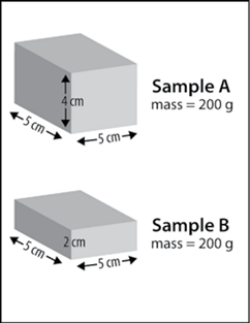
Hint: The size, mass, and arrangement of molecules affect the density of a substance. There are several possible answers for why sample B is more dense than sample A.
- Sample B atoms might have more mass than Sample A atoms.
- Sample B atoms might be smaller than Sample A atoms so more can fit in the same volume.
- Sample B atoms might be arranged differently so more Sample B atoms than Sample A atoms fit in the same size cube.
Any one of these explanations alone, or any combination, could be the reason why Sample B is more dense than Sample A.
What is the 5-E format?
The 5-E instructional model is an approach to teaching and learning that focuses on active engagement, inquiry-based learning, and collaboration.
Downloads
For Students
- Lesson 3.1 Student Activity Sheet PDF | DOCX | Google Doc
For Teachers
- Lesson 3.1 Lesson Plan PDF | DOCX | Google Doc
- Lesson 3.1 Activity Sheet Answers PDF | DOCX | Google Doc
Resources for the entire Chapter 3
- Chapter 3 Student Reading PDF | DOCX | Google Doc
- Chapter 3 Test Bank PDF | DOCX | Google Doc
Interactive Lesson Modules
- Lesson 3.1 Online Assignments Google Form
Have Questions? Visit Help Center

